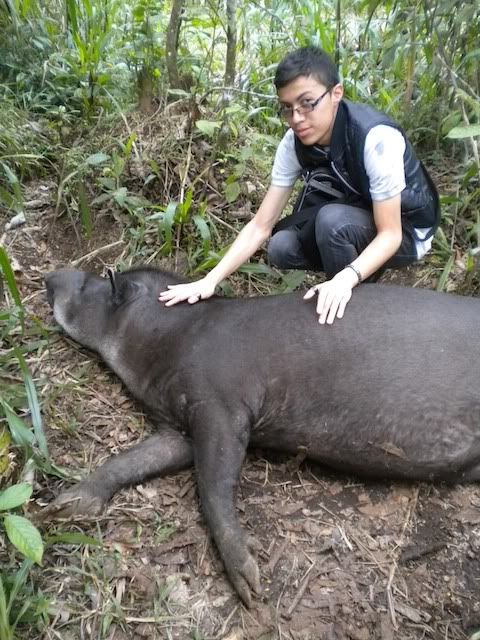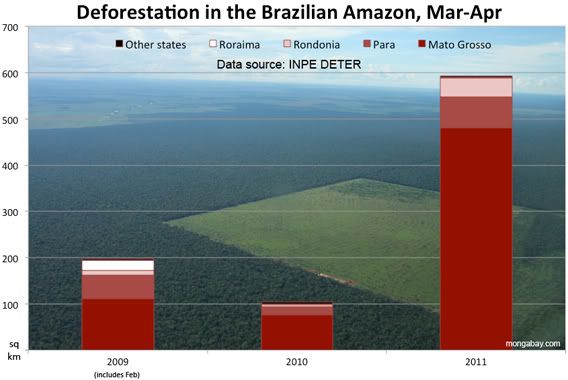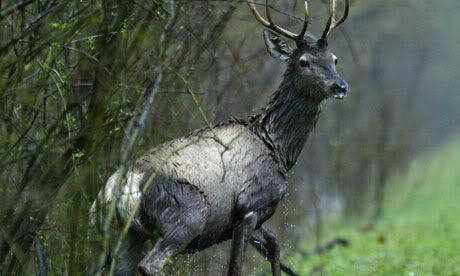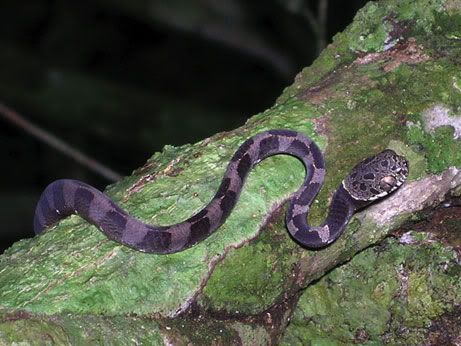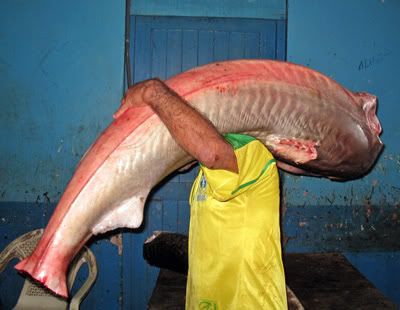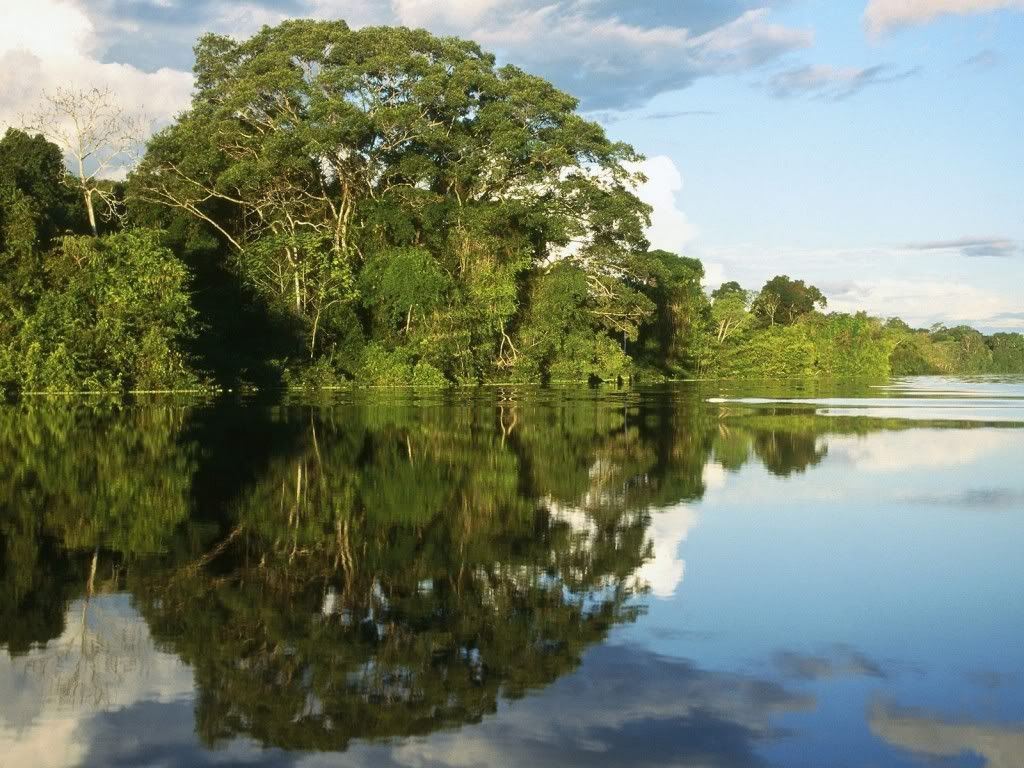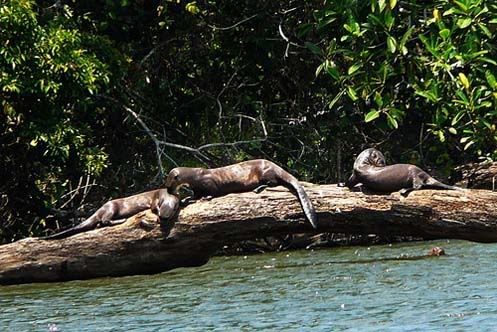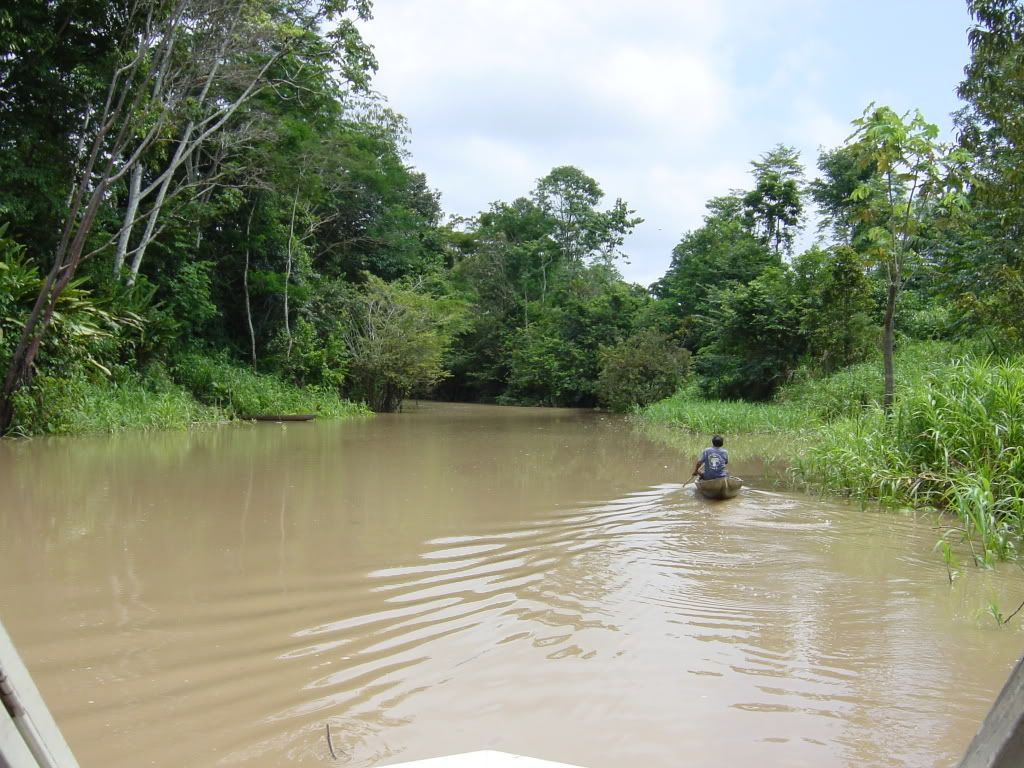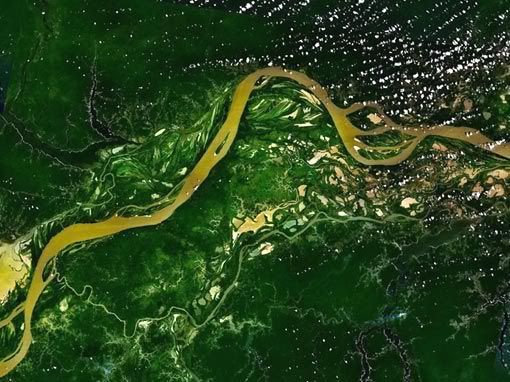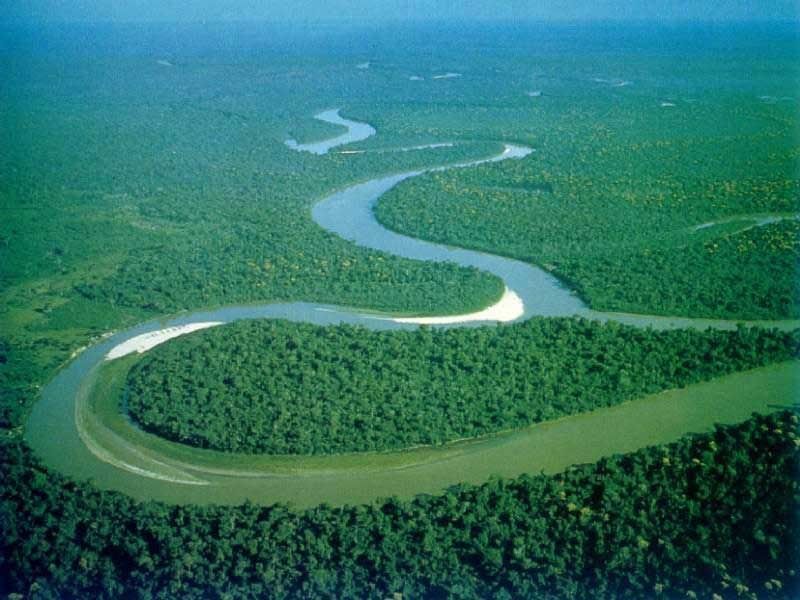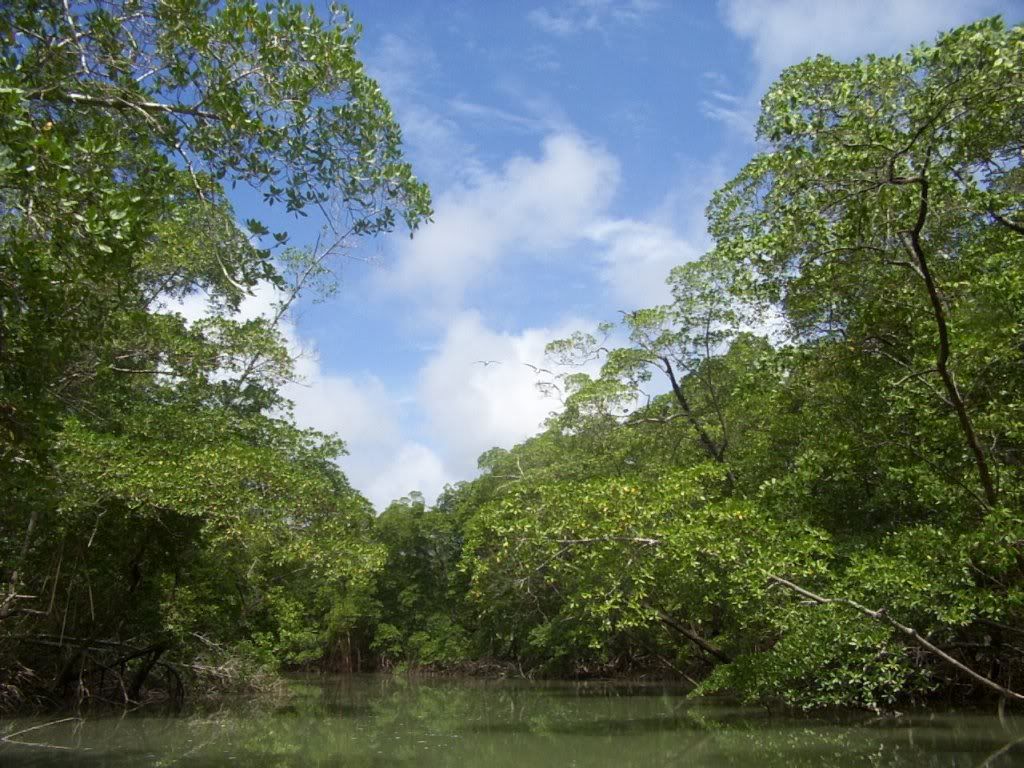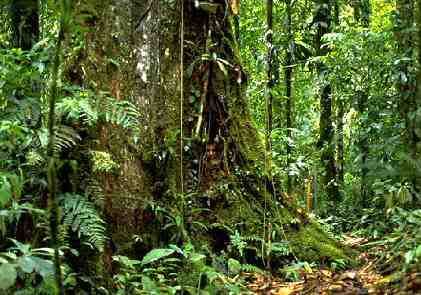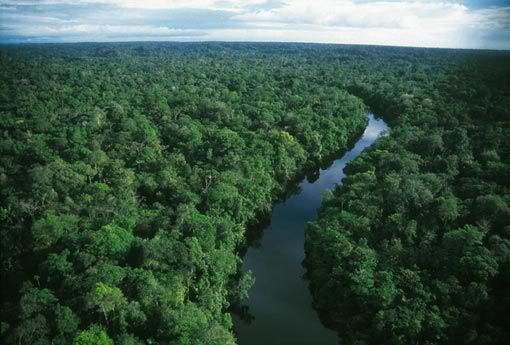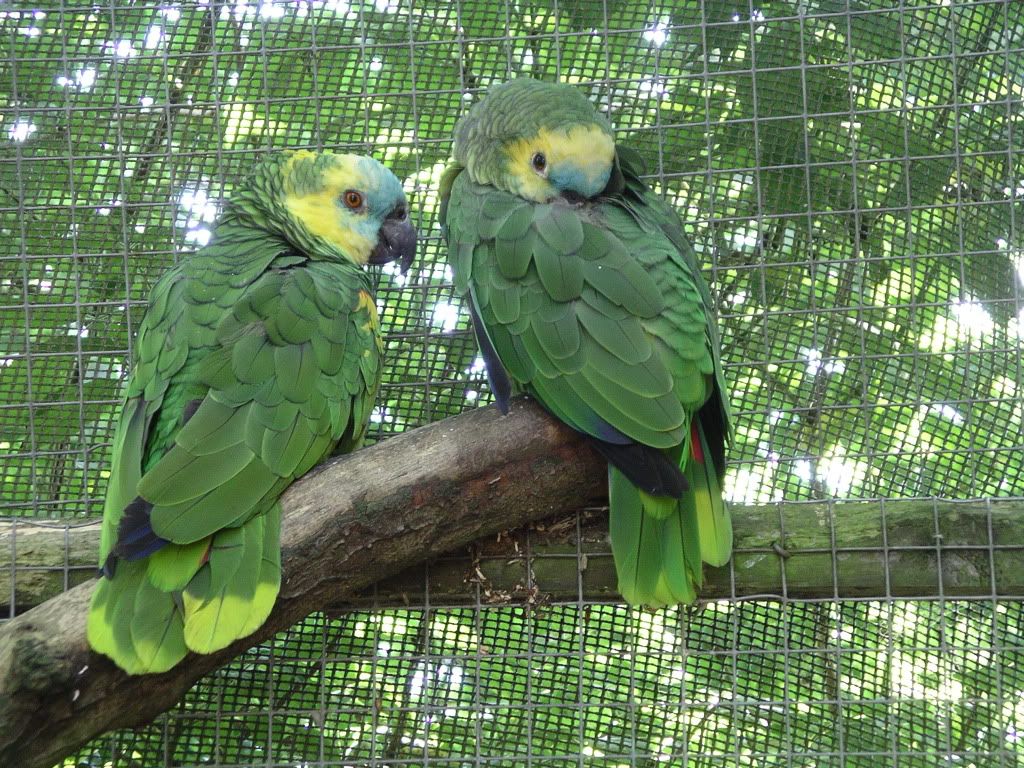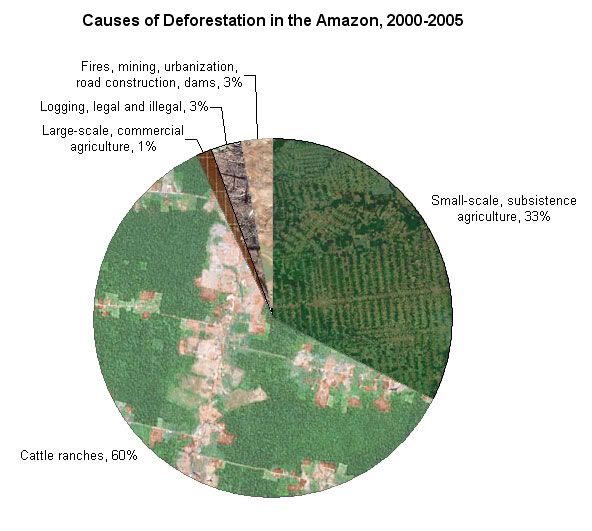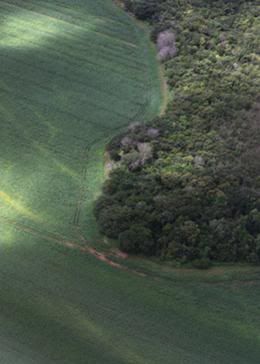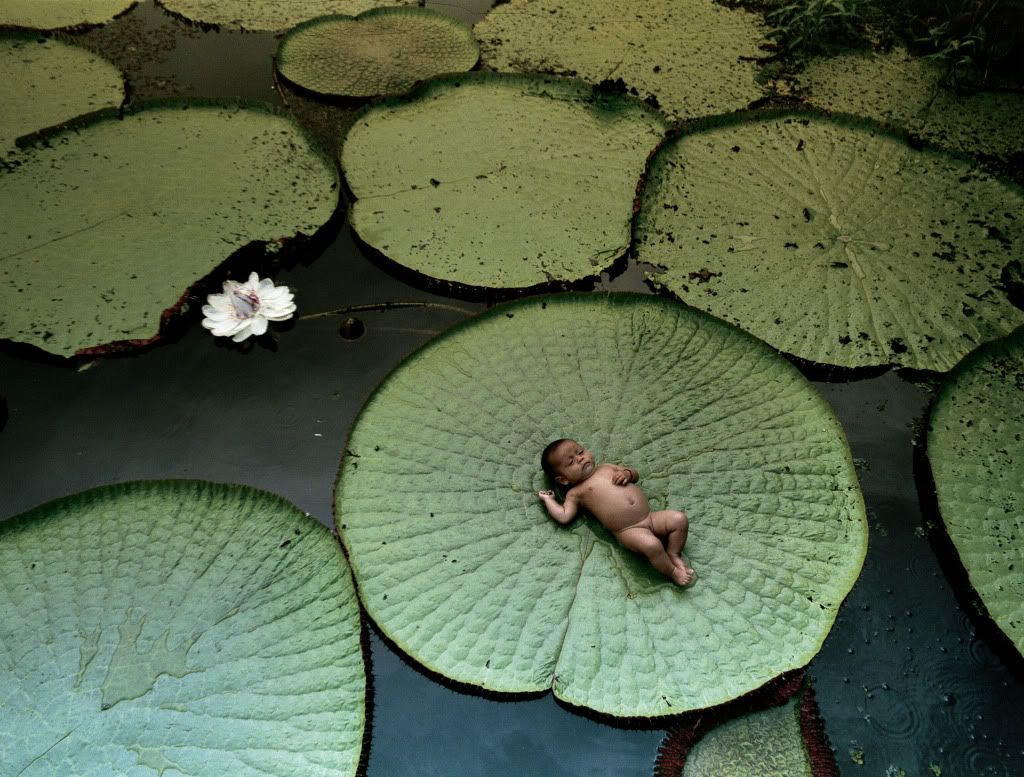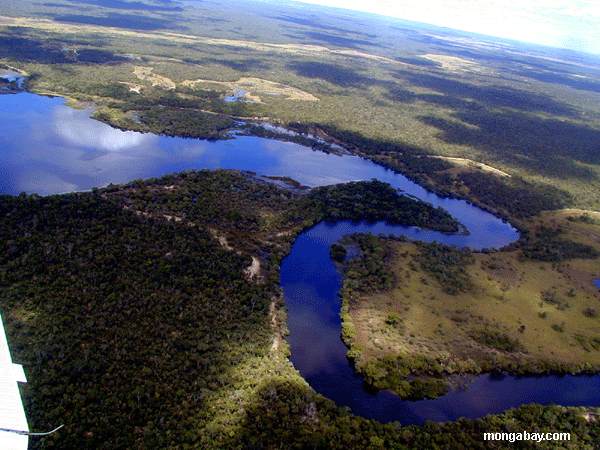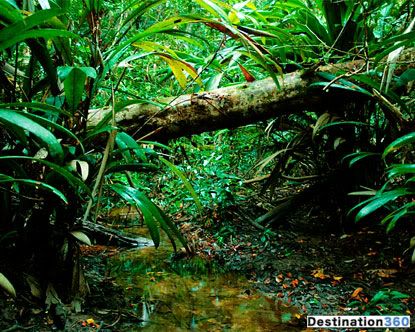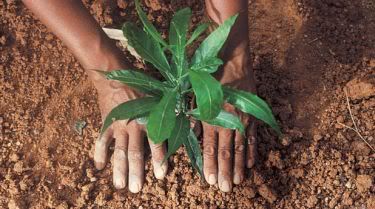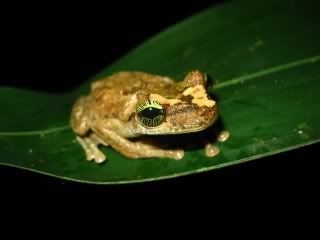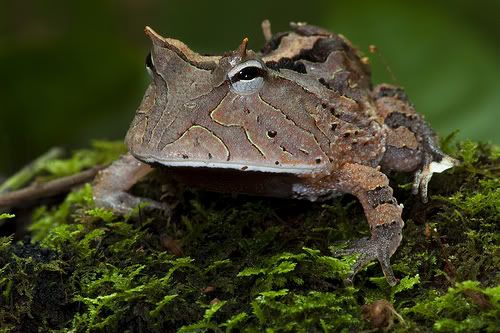A community leader in the Brazilian Amazon was slain Friday just three days after two environmentalists were killed in a neighboring state, reports Reuters.
Adelino "Dinho" Ramos, the president of the Movimento Camponeses Corumbiara e da Associação dos Camponeses do Amazonas, a small farmers association, was gunned down front of his family Friday morning in Rondônia. Brazil's Special Secretariat for Human Rights, an office of the president, said it was unclear who killed Ramos, who had received death threats from loggers. Ramos survived a 1995 massacre in which 13 people were killed.
His killing came just three days after Joao Claudio Ribeiro da Silva and his wife, Maria do Espirito Santo, were killed in an ambush near their home in the state of Pará. Suspicion immediately fell on illegal loggers linked to the charcoal trade that supplies pig iron smelters in the region. Da Silva had been a prominent environmentalist and the recipient of international recognition as well as numbers death threats.
Brazil's President Dilma Rousseff has already ordered a federal investigation into the murder of the da Silvas, which has been widely condemned.
Environmentalists say their death could catalyze further opposition to proposed changes to Brazil's Forestry Code, which would weaken protections for the Amazon rainforest. They cite the 1988 murder of rubber-tapper Chico Mendes, which helped spark global awareness of destruction of the Amazon rainforest, and the 2005 killing of Dorothy Stang, an American nun who opposed illegal logging and land-grabbing, which triggered a crack down by federal agents and the establishment of new protected areas.
The Brazilian Amazon remains a violent region. According to the Pastoral Land Commission (Comissão Pastoral da Terra) some 393 people were killed in rural land disputes between 2000 and 2010, including 71 murders in Rondonia since 2001. Crimes are rarely solved.
Tensions are presently high in the Brazilian Amazon due to rising commodity prices, which boost land values and exacerbates conflict. The agricultural lobby is pushing for a relaxation of the Forest Code to allow more rainforest to be cleared for crops and pastureland. The present Forest Code requires farmers and ranchers to maintain 80 percent forest cover on their land, although the rule is widely ignored.
Anticipation of amnesty for illegal deforestation under the new Forest Code is thought to be a contributing factor in a sharp rise in deforestation over land year.
Source: mongabay.com
mountains amazon river, river amazon information,the amazon river pictures, amazon river explorers, mountains amazon
Thứ Tư, 29 tháng 6, 2011
Danube brings visitors to unspoiled Baja, but also threat of pollution
Three massive carp are floundering in a pool in the middle of the yard as Balazs Barkuti prepares to cut them up, in keeping with the strict rules set for Danube fishers. This evening his family hotel is expecting 17 visitors from Budapest. They will be staying in Baja, overlooking the island of the same name in southern Hungary, 150km from the capital. Here halászlé, or fisherman's soup, is a must, to such an extent that a great stewpot hangs at the entrance to the picturesque town.
In summer, the Baja fish-soup festival attracts hordes of visitors to the town and to the nearby Gemenc national park. People here are said to eat more fish – 66kg a year on average – than anywhere else in Europe.
The nature reserve, with its many islands and quiet inlets, is still in more or less the same state as before the great river was regulated. The park is renowned for its century-old willows and great oaks, its black storks, trees and red deer.
"Ever since I was a child I have dreamt of living here," says Barkuti, 32. "The island hasn't changed in 100 years and I want it to stay the way it is for my two children to enjoy." Barkuti's dream came true five years ago when he left Budapest and a job stuck in front of a computer. "I enjoyed the excitement of the city but after a while I'd had enough," he says. "There aren't many places in the world you can find the peace and quiet we have here on the banks of the Danube."
However, in the course of its 2,850km journey across Europe, from the Black Forest in Germany to the Black Sea in Romania, the river suffers a great deal. Dams and reservoirs have damaged its reputation as a natural waterway, pollution and waste have soiled its water. Last year, toxic sludge was released into the Danube after a dam burst at an alumina plant. "In the morning I hear a series of tiny explosions," Barkuti says. "The reed beds along the river bank trap the plastic bottles as they float past. When the sun heats them up, they go pop!"
In September 2009, Hungary and Croatia agreed to protect the area between the Danube and the rivers Mura and Drava. This set in motion a process that culminated at the end of March when the first two countries were joined by Austria, Slovenia and Serbia. Together they established a trans-border Unesco biosphere reserve to protect Europe's Amazon, a scheme that the green campaigning group WWF had been advocating for about 10 years.
The new protected area extends over five countries, along 700km of river, and encompasses some 800,000 hectares of unique natural and historic landscape. It is Europe's largest riverine protected area.
The reserve is home to white-tailed sea eagles – with Europe's highest concentration of nesting pairs – and other endangered species such as little terns, black storks and sturgeon. It is also a vital stopover for more than 250,000 migrating birds.
"The rare species we see here know nothing about borders," says Tibor Parrag, head of nature conservation at the Danube-Drava national park. "It was essential to create a nature reserve to protect biodiversity. The agreement signed by the five countries will act as a catalyst for all of us."
This seems to suit local residents. Every year some 50,000 visitors flock to Baja (population 40,000). Cross-border protection of the Danube secures the region's future as a tourist destination. "Apart from tropical rainforest, there is no equivalent in terms of biodiversity to these flooded lowlands," says Arno Mohl, the Mura-Drava-Danube biosphere reserve project leader at WWF Austria. "The reserve will also play a key role in promoting eco-tourism. We hope the agreement will put an end to unsustainable schemes to regulate the rivers, as well as sand and gravel dredging, which still threatens this exceptional river ecosystem."
Under the European Union strategy for the Danube, decided on 13 April, which places considerable emphasis on environmental improvements, funding will be redirected to the nature reserve, which has yet to receive the Unesco seal of approval.
Along the riverfront in Baja the cafe terraces are packed. Barkuti is welcoming his guests, who have just arrived. He promises them a candle-lit dinner on the terrace overlooking his garden. "There was a time when we could drink the water from the Danube and use it for making soup," he says.
"I don't know if that'll be possible in the future, but if we stop throwing all our rubbish in the river, the fish will be pleased. And it make no sense dividing up the Danube with borders. The river will have a future if the countries join forces to protect it. The pact they've just signed is a good start."
In summer, the Baja fish-soup festival attracts hordes of visitors to the town and to the nearby Gemenc national park. People here are said to eat more fish – 66kg a year on average – than anywhere else in Europe.
The nature reserve, with its many islands and quiet inlets, is still in more or less the same state as before the great river was regulated. The park is renowned for its century-old willows and great oaks, its black storks, trees and red deer.
"Ever since I was a child I have dreamt of living here," says Barkuti, 32. "The island hasn't changed in 100 years and I want it to stay the way it is for my two children to enjoy." Barkuti's dream came true five years ago when he left Budapest and a job stuck in front of a computer. "I enjoyed the excitement of the city but after a while I'd had enough," he says. "There aren't many places in the world you can find the peace and quiet we have here on the banks of the Danube."
However, in the course of its 2,850km journey across Europe, from the Black Forest in Germany to the Black Sea in Romania, the river suffers a great deal. Dams and reservoirs have damaged its reputation as a natural waterway, pollution and waste have soiled its water. Last year, toxic sludge was released into the Danube after a dam burst at an alumina plant. "In the morning I hear a series of tiny explosions," Barkuti says. "The reed beds along the river bank trap the plastic bottles as they float past. When the sun heats them up, they go pop!"
In September 2009, Hungary and Croatia agreed to protect the area between the Danube and the rivers Mura and Drava. This set in motion a process that culminated at the end of March when the first two countries were joined by Austria, Slovenia and Serbia. Together they established a trans-border Unesco biosphere reserve to protect Europe's Amazon, a scheme that the green campaigning group WWF had been advocating for about 10 years.
The new protected area extends over five countries, along 700km of river, and encompasses some 800,000 hectares of unique natural and historic landscape. It is Europe's largest riverine protected area.
The reserve is home to white-tailed sea eagles – with Europe's highest concentration of nesting pairs – and other endangered species such as little terns, black storks and sturgeon. It is also a vital stopover for more than 250,000 migrating birds.
"The rare species we see here know nothing about borders," says Tibor Parrag, head of nature conservation at the Danube-Drava national park. "It was essential to create a nature reserve to protect biodiversity. The agreement signed by the five countries will act as a catalyst for all of us."
This seems to suit local residents. Every year some 50,000 visitors flock to Baja (population 40,000). Cross-border protection of the Danube secures the region's future as a tourist destination. "Apart from tropical rainforest, there is no equivalent in terms of biodiversity to these flooded lowlands," says Arno Mohl, the Mura-Drava-Danube biosphere reserve project leader at WWF Austria. "The reserve will also play a key role in promoting eco-tourism. We hope the agreement will put an end to unsustainable schemes to regulate the rivers, as well as sand and gravel dredging, which still threatens this exceptional river ecosystem."
Under the European Union strategy for the Danube, decided on 13 April, which places considerable emphasis on environmental improvements, funding will be redirected to the nature reserve, which has yet to receive the Unesco seal of approval.
Along the riverfront in Baja the cafe terraces are packed. Barkuti is welcoming his guests, who have just arrived. He promises them a candle-lit dinner on the terrace overlooking his garden. "There was a time when we could drink the water from the Danube and use it for making soup," he says.
"I don't know if that'll be possible in the future, but if we stop throwing all our rubbish in the river, the fish will be pleased. And it make no sense dividing up the Danube with borders. The river will have a future if the countries join forces to protect it. The pact they've just signed is a good start."
Rainforest destruction up by 500 per cent…and now Brazil relaxes protection laws
An alarming increase in deforestation in Brazil just as its government has agreed to relax laws protecting the country's forests.
In the Mato Grosso area, 405.6 square kilometres of forest were destroyed in April 2011, more than in the whole of the previous year and a staggering 540 per cent increase in deforestation month on month increase, according to the National Institute for Space Studies (INPE). Worse still, under the new bill, there would be an amnesty for those who illegally cleared forest before July 2008.
Supporters of the new law say Brazil needs land to boost agricultural production, while environmentalists say destruction of the Amazon rainforest will increase. It is not gaining full support, with Brazilian President Dilma Rousseff indicated she would veto any bill that contained an amnesty.
Environment Minister Izabella Teixeira expressed concern over the latest figures, saying: ‘This is a very serious fact, atypical and contradictory. In a single month there has been more deforestation in Mato Grosso than occurred in the whole of last year.
Increase in deforestation anticipated change in law
The proposed amendment to the law by the ‘ruralistas' would make profound alterations to the law, easing restrictions on farmers and requirements about how much they should replant. The changes were proposed by Aldo Rebelo form Brazil's Communist Party (PCdoB), who argued that the existing rules prevented small farmers from making best use of their land to lift themselves out of poverty and supported by groups representing farmers' interests.
Brazil's Forest Law (also known as the Forest Code) was first enacted in 1934 and determines how much a landowner can deforest and how much must be kept as a ‘legal reserve'. Before this month's decision, Brazil's Forest Law requires landowners in the Amazon to allow 80 per cent of a property to remain forested but in the tropical savannah region this falls to just 20 per cent. The final terms of the amended bill are still being debated.
The increase in deforestation is happening in regions where Mato Grosso's agribusiness is expanding, and is thought to be directly linked to the expectation that the amendment to the Forest Law will be approved.
Cleared to make way for soya production
Rainforest is being replaced by lucrative soya fields according to WWF-Brazil's Conservation Director Carlos Alberto de Mattos Scaramuzza: ‘The numbers reflect confidence in the promise made by the "ruralista" faction (representing agribusiness interests) in parliament that there will be a general amnesty for all illegal deforestation brought about by agribusiness.'
Much of the deforestation has been in the soya-growing region of Sinop, driven by spiraling market prices. On average, the profitability of soya is somewhere between 300 and 500 reais (£115 and £190) a hectare. But at the moment that has escalated to 1,000 reais (£380) a hectare, making it extraordinarily lucrative.
‘That assurance of extremely high profits associated with the expectation of generalised impunity as a consequence of the Forest Law amendment, has contributed immensely to stimulating the criminal deforestation we are witnessing in Mato Grosso today,' Scaramuzza said.
Mato Grosso - which translates to ‘Thick Wood' - is home to some of the most biodiverse swathes of rainforest in the country.
In the Mato Grosso area, 405.6 square kilometres of forest were destroyed in April 2011, more than in the whole of the previous year and a staggering 540 per cent increase in deforestation month on month increase, according to the National Institute for Space Studies (INPE). Worse still, under the new bill, there would be an amnesty for those who illegally cleared forest before July 2008.
Supporters of the new law say Brazil needs land to boost agricultural production, while environmentalists say destruction of the Amazon rainforest will increase. It is not gaining full support, with Brazilian President Dilma Rousseff indicated she would veto any bill that contained an amnesty.
Environment Minister Izabella Teixeira expressed concern over the latest figures, saying: ‘This is a very serious fact, atypical and contradictory. In a single month there has been more deforestation in Mato Grosso than occurred in the whole of last year.
Increase in deforestation anticipated change in law
The proposed amendment to the law by the ‘ruralistas' would make profound alterations to the law, easing restrictions on farmers and requirements about how much they should replant. The changes were proposed by Aldo Rebelo form Brazil's Communist Party (PCdoB), who argued that the existing rules prevented small farmers from making best use of their land to lift themselves out of poverty and supported by groups representing farmers' interests.
Brazil's Forest Law (also known as the Forest Code) was first enacted in 1934 and determines how much a landowner can deforest and how much must be kept as a ‘legal reserve'. Before this month's decision, Brazil's Forest Law requires landowners in the Amazon to allow 80 per cent of a property to remain forested but in the tropical savannah region this falls to just 20 per cent. The final terms of the amended bill are still being debated.
The increase in deforestation is happening in regions where Mato Grosso's agribusiness is expanding, and is thought to be directly linked to the expectation that the amendment to the Forest Law will be approved.
Cleared to make way for soya production
Rainforest is being replaced by lucrative soya fields according to WWF-Brazil's Conservation Director Carlos Alberto de Mattos Scaramuzza: ‘The numbers reflect confidence in the promise made by the "ruralista" faction (representing agribusiness interests) in parliament that there will be a general amnesty for all illegal deforestation brought about by agribusiness.'
Much of the deforestation has been in the soya-growing region of Sinop, driven by spiraling market prices. On average, the profitability of soya is somewhere between 300 and 500 reais (£115 and £190) a hectare. But at the moment that has escalated to 1,000 reais (£380) a hectare, making it extraordinarily lucrative.
‘That assurance of extremely high profits associated with the expectation of generalised impunity as a consequence of the Forest Law amendment, has contributed immensely to stimulating the criminal deforestation we are witnessing in Mato Grosso today,' Scaramuzza said.
Mato Grosso - which translates to ‘Thick Wood' - is home to some of the most biodiverse swathes of rainforest in the country.
Authorities launch stealth operation in Amazon after satellite images reveal deforestation
Brazil’s environmental enforcement agency busted an illegal logging ring following analysis of satellite imagery, reports Globo.
Illegal loggers managed to clear more than 400 hectares of Amazon rainforest in southeast Pará before authorities spotted the crime using Brazil’s satellite-based deforestation detection system.. Brazil’s environmental enforcement agency, the Institute of the Environment and Natural Resources (IBAMA), responded by dispatching agents to surprise deforesters in the act of clearing rainforest.
In its action, IBAMA officers confiscated a tractor used to haul logs and maintain access roads in the rainforest, two trucks used to transport illegally sourced wood, and 200 liters of diesel. The agency fined the owner of the equipment R$2 million ($1.2 million) for environmental crimes. Based on the equipment found, IBAMA believes that the perpetrators planned to high-grade and then clear-cut at least a thousand hectares of primary forest for cattle pasture.
IBAMA caught three men cutting timber, but as is often the case, a more powerful player—a local landholder wanting to illegally expand his property—had hired the men. Luciano Silva, the coordinator of this IBAMA operation, explained that after the forest has been cleared by workers and converted to pasture, large landholders, known as fazendeiros, will often petition the local Environmental Rural Register (CAR) and attempt to legalize their claims to the newly deforested land. Legally, if the connection between the fazendeiro and the workers clearing land can be proven, he can be fined R$5,000 ($3,100) for each hectare of destroyed forest as an accomplice to environmental crime. Such proof is rarely forthcoming, thus those providing the impetus for deforestation are usually not held responsible.
Also, given IBAMA's extremely poor track record of collecting fines—less than one percent between 2005 and 2010 according to Brazil’s Globo news agency—no one may be held accountable for this instance of Amazon rainforest degradation.
Illegal loggers managed to clear more than 400 hectares of Amazon rainforest in southeast Pará before authorities spotted the crime using Brazil’s satellite-based deforestation detection system.. Brazil’s environmental enforcement agency, the Institute of the Environment and Natural Resources (IBAMA), responded by dispatching agents to surprise deforesters in the act of clearing rainforest.
In its action, IBAMA officers confiscated a tractor used to haul logs and maintain access roads in the rainforest, two trucks used to transport illegally sourced wood, and 200 liters of diesel. The agency fined the owner of the equipment R$2 million ($1.2 million) for environmental crimes. Based on the equipment found, IBAMA believes that the perpetrators planned to high-grade and then clear-cut at least a thousand hectares of primary forest for cattle pasture.
IBAMA caught three men cutting timber, but as is often the case, a more powerful player—a local landholder wanting to illegally expand his property—had hired the men. Luciano Silva, the coordinator of this IBAMA operation, explained that after the forest has been cleared by workers and converted to pasture, large landholders, known as fazendeiros, will often petition the local Environmental Rural Register (CAR) and attempt to legalize their claims to the newly deforested land. Legally, if the connection between the fazendeiro and the workers clearing land can be proven, he can be fined R$5,000 ($3,100) for each hectare of destroyed forest as an accomplice to environmental crime. Such proof is rarely forthcoming, thus those providing the impetus for deforestation are usually not held responsible.
Also, given IBAMA's extremely poor track record of collecting fines—less than one percent between 2005 and 2010 according to Brazil’s Globo news agency—no one may be held accountable for this instance of Amazon rainforest degradation.
New uncontacted tribe discovered in Brazil needs to be protected from outsiders, scientists warn
Officials from Brazil's Indian affairs agency, FUNAI, have confirmed the existence of more than two dozen 'uncontacted' tribes within previously unknown indigenous group in the rugged folds of the western Amazon.
Members of an uncontacted Amazon Basin tribe and their dwellings are seen during a flight over the Brazilian state of Acre along the border with Peru in this May 2008 photo distributed by Survival International. Survival International estimates that there are over 100 uncontacted tribes worldwide, and says that uncontacted tribes in the region are under increasing threat from illegal logging over the border in Peru.
Brazilian Authorities say the remote group likely numbers around 200 members, living in traditionally built huts, called malocas, surrounded by small farms of nuts, banana, and corn.
According to the National Indian Foundation, (FUNAI), a government organization aimed at preserving the rights of the indigenous, researchers first became aware of the possible existence of an uncontacted tribe after finding several small gaps in the forest while reviewing satellite imagery of the Javari Valley in the western Amazon, near Brazil's border with Peru.
In April, an overflight examination of the region confirmed the presence a settlement composed of three cleared agricultural areas and four malocas.
The expedition coordinator Fabricio Amorim says that confirming such discoveries requires years of careful research, following guidelines geared towards protecting uncontacted tribes.
From the flyover photographs, FUNAI has been able to make certain determinations about the mysterious and remote settlement.
"The crops as well as the malocas are new, dated within a year. The state of straw used in the construction, and size of the corn indicate [its age]. Besides corn, there was a banana and undergrowth that appeared to be peanuts, among other crops," says Amorim in a statement released by FUNAI.
However as Amorim explained, despite the settlement's geographic isolation, these indigenous peoples are not entirely protected from outside activities.
"The main threats to the integrity of these groups are illegal fishing, hunting, logging, mining, agro-pastoralists with large clearings, missionary activities and frontier situations, such as drug trafficking," says Amorim. "Another situation that requires care is the oil exploration in Peru, which could have an impact on Javari Valley."
Around 2,000 uncontacted Indians are said to be in the Javari valley and according to National Geographic the Javari Valley is a dense rain forest area, half the size of Florida.
However, most of the uncontacted Indian tribes fall victims to diseases communicated through contact with outsiders.
Survival International reported that hunter-gatherer nomadic groups known as "Maku" who dwell in headwaters of the northwest Amazon basin have been hit with a respiratory disease. Around 35 Nukak-Maku have been admitted to San José del Guaviare hospital in the southern Colombian Amazon. Most of the tribe members have been living in refugee camps outside San José since being ousted from their rainforest abode by guerrilla armies.
The tribe emerged from the forests in 1988 and since then half of the tribe members have lost their lives.
In order to protect and preserve the newly discovered tribe, FUNAI has thus insisted it does not plan on releasing the specifics as to its location in a region home to approximately 14 other uncontacted tribes accounted for so far.
Source: International Business Times
Members of an uncontacted Amazon Basin tribe and their dwellings are seen during a flight over the Brazilian state of Acre along the border with Peru in this May 2008 photo distributed by Survival International. Survival International estimates that there are over 100 uncontacted tribes worldwide, and says that uncontacted tribes in the region are under increasing threat from illegal logging over the border in Peru.
Brazilian Authorities say the remote group likely numbers around 200 members, living in traditionally built huts, called malocas, surrounded by small farms of nuts, banana, and corn.
According to the National Indian Foundation, (FUNAI), a government organization aimed at preserving the rights of the indigenous, researchers first became aware of the possible existence of an uncontacted tribe after finding several small gaps in the forest while reviewing satellite imagery of the Javari Valley in the western Amazon, near Brazil's border with Peru.
In April, an overflight examination of the region confirmed the presence a settlement composed of three cleared agricultural areas and four malocas.
The expedition coordinator Fabricio Amorim says that confirming such discoveries requires years of careful research, following guidelines geared towards protecting uncontacted tribes.
From the flyover photographs, FUNAI has been able to make certain determinations about the mysterious and remote settlement.
"The crops as well as the malocas are new, dated within a year. The state of straw used in the construction, and size of the corn indicate [its age]. Besides corn, there was a banana and undergrowth that appeared to be peanuts, among other crops," says Amorim in a statement released by FUNAI.
However as Amorim explained, despite the settlement's geographic isolation, these indigenous peoples are not entirely protected from outside activities.
"The main threats to the integrity of these groups are illegal fishing, hunting, logging, mining, agro-pastoralists with large clearings, missionary activities and frontier situations, such as drug trafficking," says Amorim. "Another situation that requires care is the oil exploration in Peru, which could have an impact on Javari Valley."
Around 2,000 uncontacted Indians are said to be in the Javari valley and according to National Geographic the Javari Valley is a dense rain forest area, half the size of Florida.
However, most of the uncontacted Indian tribes fall victims to diseases communicated through contact with outsiders.
Survival International reported that hunter-gatherer nomadic groups known as "Maku" who dwell in headwaters of the northwest Amazon basin have been hit with a respiratory disease. Around 35 Nukak-Maku have been admitted to San José del Guaviare hospital in the southern Colombian Amazon. Most of the tribe members have been living in refugee camps outside San José since being ousted from their rainforest abode by guerrilla armies.
The tribe emerged from the forests in 1988 and since then half of the tribe members have lost their lives.
In order to protect and preserve the newly discovered tribe, FUNAI has thus insisted it does not plan on releasing the specifics as to its location in a region home to approximately 14 other uncontacted tribes accounted for so far.
Source: International Business Times
Thứ Ba, 28 tháng 6, 2011
How South America's Rainforests Are Being Sacrificed on the Altar of Energy
The construction of five hydroelectric dams in Peru as part of an energy deal with Brazil will do considerable damage to the environment, such as the destruction of nearly 1.5 million hectares of jungle over the next 20 years, according to an independent study.
More than 1,000 km of roads will have to be carved out of primary and secondary forests to build the dams and power plants and put up power lines, says the report, carried out by engineer José Serra for ProNaturaleza, a leading conservation organisation in Peru.
The dams to be built under the agreement signed by the two South American nations in June will have a projected potential of 7,200 megawatts.
The energy complexes include the Inambari dam, to be built where the provinces of Cuzco, Madre de Dios and Puno converge in the Amazon rainforest in southeastern Peru. The hydropower project will be the largest in Peru and the fifth largest in Latin America.
The next in size will be Paquitzapango on the Ene river in the central province of Junín, home to the Asháninka Indians. The other three projected dams are Mainique 1 in Cuzco, and Tambo 40 and Tambo 60, in Junín.
The total combined investment is estimated at between 13.5 and 16.5 billion dollars.
Serra's study, "Inambari: la urgencia de una discusión seria y nacional" (Inambari: the urgent need for a serious national debate), highlights the great variety of flora and fauna, including endangered and threatened species, in the areas to be flooded.
For example, the extremely rare Black Tinamou (Tinamus osgoodi), a threatened species of ground bird, is found in the area where the Inambari dam is to be built.
"There will be a serious impact on the Amazon ecosystems," Serra told IPS.
Extrapolating from past developments in the Amazon, he projects that 1,446,000 hectares of well-preserved rainforest will disappear over the next 20 years, as a result of the construction of the five hydropower dams.
That estimate takes into account a 10-km strip that would be deforested along each of the roads that have to be built in order to install the transmission towers and power lines.
It does not consider further deforestation in areas already degraded by the construction of the Southern Interoceanic Highway, which will link the Amazon jungle state of Acre in Brazil with several Pacific port cities in Peru.
The study mentions a number of impacts for the Inambari and Araza river basins, such as the dams' interruption of the migration of many species of fish upriver to their breeding grounds, which will in turn affect riverbank populations that depend on fish as a staple food.
Peru ranks fifth in the world in terms of diversity of fish species, with more than 1,000 species, around 600 of which can be found in the Madre de Dios river alone, the report says.
If these areas are deforested, the study also warns, sedimentation would build up even faster in the reservoirs, reducing the availability of nutrients in the water, which would hurt the river ecosystems downriver and the forests that depend on the nutrients.
In addition, the rotting vegetation in the reservoirs will contribute to the generation of greenhouse gases like methane, over 20 times more powerful at warming the atmosphere than carbon dioxide.
In Serra's view, it is simply unsustainable to say that hydropower is a form of clean energy.
The mud that accumulates in the reservoirs is similar to the tailings water generated by the mining industry, in the sense that it holds all kinds of chemical pollutants that can be lethal, the report adds.
The Inambari hydroelectric project is to be built partly in the buffer zone of the Bahuaja-Sonene National Park, one of the most biodiverse natural reserves in the country.
The Brazilian consortium Egasur (Southern Amazon Electrical Generation Company), which is to build Inambari, identified 139 species of trees, bushes and other plants in the area to be flooded. And 50 species of amphibians and 203 kinds of birds have been identified in the dry season.
The company also found 25 species of medium to large sized mammals. Local residents in the area told IPS that animals there include the lowland or Brazilian tapir, the jaguar, and the paca, a large rodent.
Mariano Castro, an expert with the Peruvian Society for Environmental Law, told IPS that "the state only puts a priority on the economic and commercial dimension, without considering the natural value of these places or the high environmental costs.
"What's more, there is a belief that these environmental considerations hinder private investment, and there is no acknowledgement that these are requisites necessary for developing sustainable investment," he said.
Congressman Yonhy Lescano said President Alan García told him that Egasur planned to pull out of Inambari. But neither the company nor the government has confirmed the report.
Experts believe it is unlikely because Inambari Geração de Energía, Egasur's parent company, recently increased its capital -- an indication that it intends to expand, rather than close down, projects.
Meanwhile, fears are rising among 18 Asháninka communities and 33 other human settlements that would be displaced by the flooding caused by the Paquitzapango dam, to be built on the Ene river by Odebrecht, one of Brazil's largest construction companies.
The natural ebb and flow of the Ene river and its tributaries will be modified in that area, along with the availability of fish for human consumption, Ernesto Ráez, a biologist with the Cayetano Heredia University's Centre for Environmental Sustainability, told IPS.
The Mainique dam, for its part, is slated to be built in an area that is sacred to the Matsiguenga indigenous people, who live in the jungle along the Urubamba river in Cuzco province.
The sacred spot is the Pongo de Mainique, a narrow whitewater canyon with abundant fish species that forms part of the Megantoni National Sanctuary, a nature reserve.
Before signing the agreement with Brazil, the Peruvian government should have commissioned an environmental impact study, to assess the damages, Castro remarked to IPS.
He also said it was a mistake not to include in the decision-making process environmental regulatory agencies and government bodies that work with indigenous communities.
Energy experts say Peru does not need to tap Amazon jungle resources to meet domestic demand for electricity, because the country's installed capacity of more than 6,000 megawatts is sufficient to cover current needs.
They also say future demand, projected to grow to 12,000 megawatts by 2020, will easily be covered by the wind energy potential of the country's Andean highlands and coastal regions, estimated at 22,000 megawatts.
But going against the grain of recommendations, the García administration introduced a bill in Congress in October that would waive the requirement for companies granted concessions to build hydropower dams to present environmental impact studies
More than 1,000 km of roads will have to be carved out of primary and secondary forests to build the dams and power plants and put up power lines, says the report, carried out by engineer José Serra for ProNaturaleza, a leading conservation organisation in Peru.
The dams to be built under the agreement signed by the two South American nations in June will have a projected potential of 7,200 megawatts.
The energy complexes include the Inambari dam, to be built where the provinces of Cuzco, Madre de Dios and Puno converge in the Amazon rainforest in southeastern Peru. The hydropower project will be the largest in Peru and the fifth largest in Latin America.
The next in size will be Paquitzapango on the Ene river in the central province of Junín, home to the Asháninka Indians. The other three projected dams are Mainique 1 in Cuzco, and Tambo 40 and Tambo 60, in Junín.
The total combined investment is estimated at between 13.5 and 16.5 billion dollars.
Serra's study, "Inambari: la urgencia de una discusión seria y nacional" (Inambari: the urgent need for a serious national debate), highlights the great variety of flora and fauna, including endangered and threatened species, in the areas to be flooded.
For example, the extremely rare Black Tinamou (Tinamus osgoodi), a threatened species of ground bird, is found in the area where the Inambari dam is to be built.
"There will be a serious impact on the Amazon ecosystems," Serra told IPS.
Extrapolating from past developments in the Amazon, he projects that 1,446,000 hectares of well-preserved rainforest will disappear over the next 20 years, as a result of the construction of the five hydropower dams.
That estimate takes into account a 10-km strip that would be deforested along each of the roads that have to be built in order to install the transmission towers and power lines.
It does not consider further deforestation in areas already degraded by the construction of the Southern Interoceanic Highway, which will link the Amazon jungle state of Acre in Brazil with several Pacific port cities in Peru.
The study mentions a number of impacts for the Inambari and Araza river basins, such as the dams' interruption of the migration of many species of fish upriver to their breeding grounds, which will in turn affect riverbank populations that depend on fish as a staple food.
Peru ranks fifth in the world in terms of diversity of fish species, with more than 1,000 species, around 600 of which can be found in the Madre de Dios river alone, the report says.
If these areas are deforested, the study also warns, sedimentation would build up even faster in the reservoirs, reducing the availability of nutrients in the water, which would hurt the river ecosystems downriver and the forests that depend on the nutrients.
In addition, the rotting vegetation in the reservoirs will contribute to the generation of greenhouse gases like methane, over 20 times more powerful at warming the atmosphere than carbon dioxide.
In Serra's view, it is simply unsustainable to say that hydropower is a form of clean energy.
The mud that accumulates in the reservoirs is similar to the tailings water generated by the mining industry, in the sense that it holds all kinds of chemical pollutants that can be lethal, the report adds.
The Inambari hydroelectric project is to be built partly in the buffer zone of the Bahuaja-Sonene National Park, one of the most biodiverse natural reserves in the country.
The Brazilian consortium Egasur (Southern Amazon Electrical Generation Company), which is to build Inambari, identified 139 species of trees, bushes and other plants in the area to be flooded. And 50 species of amphibians and 203 kinds of birds have been identified in the dry season.
The company also found 25 species of medium to large sized mammals. Local residents in the area told IPS that animals there include the lowland or Brazilian tapir, the jaguar, and the paca, a large rodent.
Mariano Castro, an expert with the Peruvian Society for Environmental Law, told IPS that "the state only puts a priority on the economic and commercial dimension, without considering the natural value of these places or the high environmental costs.
"What's more, there is a belief that these environmental considerations hinder private investment, and there is no acknowledgement that these are requisites necessary for developing sustainable investment," he said.
Congressman Yonhy Lescano said President Alan García told him that Egasur planned to pull out of Inambari. But neither the company nor the government has confirmed the report.
Experts believe it is unlikely because Inambari Geração de Energía, Egasur's parent company, recently increased its capital -- an indication that it intends to expand, rather than close down, projects.
Meanwhile, fears are rising among 18 Asháninka communities and 33 other human settlements that would be displaced by the flooding caused by the Paquitzapango dam, to be built on the Ene river by Odebrecht, one of Brazil's largest construction companies.
The natural ebb and flow of the Ene river and its tributaries will be modified in that area, along with the availability of fish for human consumption, Ernesto Ráez, a biologist with the Cayetano Heredia University's Centre for Environmental Sustainability, told IPS.
The Mainique dam, for its part, is slated to be built in an area that is sacred to the Matsiguenga indigenous people, who live in the jungle along the Urubamba river in Cuzco province.
The sacred spot is the Pongo de Mainique, a narrow whitewater canyon with abundant fish species that forms part of the Megantoni National Sanctuary, a nature reserve.
Before signing the agreement with Brazil, the Peruvian government should have commissioned an environmental impact study, to assess the damages, Castro remarked to IPS.
He also said it was a mistake not to include in the decision-making process environmental regulatory agencies and government bodies that work with indigenous communities.
Energy experts say Peru does not need to tap Amazon jungle resources to meet domestic demand for electricity, because the country's installed capacity of more than 6,000 megawatts is sufficient to cover current needs.
They also say future demand, projected to grow to 12,000 megawatts by 2020, will easily be covered by the wind energy potential of the country's Andean highlands and coastal regions, estimated at 22,000 megawatts.
But going against the grain of recommendations, the García administration introduced a bill in Congress in October that would waive the requirement for companies granted concessions to build hydropower dams to present environmental impact studies
Tropical rainforests
Tropical rainforests lie around the equator between the Tropic of Capricorn and Tropic of Cancer and cover approximately 6 percent of the Earth’s total land area. Just a few thousand years ago tropical rainforests covered as much as 12 percent of the Earth’s land surface.
MANILA, Philippines – Within the tropical zone, tropical rainforests are located in three main regions; Africa, Asia, and the Americas.
The largest unbroken stretch of rainforest is found in the Amazon River Basin of South America. Over half of the forest lies in Brazil, which holds about one-third of the world’s remaining tropical rainforests.
Tropical rainforests receive a nearly constant amount of exposure to the sun, as well as more intense energy from the sun, thus providing ideal growth conditions.
The tropical rainforests play an elemental role in regulating global weather in addition to maintaining regular rainfall, while buffering against flood, droughts, and erosion. They store vast quantities of carbon, while producing 40 percent of the world’s oxygen.
The Amazon Basin literally drives weather systems around the world. The tropics receive two-thirds of the world’s rainfall, and when it rains, water changes from liquid to vapor and back again, storing and releasing heat energy in the process.
With so much rainfall, an incredible amount of heat is released into the atmosphere – making the tropics the Earth’s primary source of heat redistribution.
The rainfall in the Amazon region is said to be decreasing due to indiscriminate deforestation.
In 2005, the Amazon forest suffered its worst drought in over 100 years raising serious environmental issues. If deforestation continues at the current rate, given the sensitive nature of Amazon’s ecosystem, no forest will be left for the future generations.
Source: Tempo
MANILA, Philippines – Within the tropical zone, tropical rainforests are located in three main regions; Africa, Asia, and the Americas.
The largest unbroken stretch of rainforest is found in the Amazon River Basin of South America. Over half of the forest lies in Brazil, which holds about one-third of the world’s remaining tropical rainforests.
Tropical rainforests receive a nearly constant amount of exposure to the sun, as well as more intense energy from the sun, thus providing ideal growth conditions.
The tropical rainforests play an elemental role in regulating global weather in addition to maintaining regular rainfall, while buffering against flood, droughts, and erosion. They store vast quantities of carbon, while producing 40 percent of the world’s oxygen.
The Amazon Basin literally drives weather systems around the world. The tropics receive two-thirds of the world’s rainfall, and when it rains, water changes from liquid to vapor and back again, storing and releasing heat energy in the process.
With so much rainfall, an incredible amount of heat is released into the atmosphere – making the tropics the Earth’s primary source of heat redistribution.
The rainfall in the Amazon region is said to be decreasing due to indiscriminate deforestation.
In 2005, the Amazon forest suffered its worst drought in over 100 years raising serious environmental issues. If deforestation continues at the current rate, given the sensitive nature of Amazon’s ecosystem, no forest will be left for the future generations.
Source: Tempo
Amazon tribe has no word for "cock"
Source: The Spoof
Scientists have discovered a remote tribe in the Brazilian rainforest who have no word to describe the male genitalia. The Dingaling tribe were only discovered in the 1970s and Brazilian linguists have been living amongst them for the last few years to decipher their language before the modern world corrupts their culture and they learn to speak using hip hop slang.
One fascinating feature of the Dingaling tribe is that they have no word for the penis. They have three words for vagina, four words for the anus, and seventy-three words to describe different regions of the perineum. But there is no word for penis.
This gives the language a charming coy appeal, as when they need to refer to the male genitalia, they will use words such as "it", "thing" and "what-do-you-call-it".
Unfortunately, the tribe also has a very primitive counting system which contains only two numbers - zero and pi. This leads to the very confusing conclusion that all men have 3.14159 "things", and also that when you bend it into a circular shape, its length will equal its girth.
Scientists have discovered a remote tribe in the Brazilian rainforest who have no word to describe the male genitalia. The Dingaling tribe were only discovered in the 1970s and Brazilian linguists have been living amongst them for the last few years to decipher their language before the modern world corrupts their culture and they learn to speak using hip hop slang.
One fascinating feature of the Dingaling tribe is that they have no word for the penis. They have three words for vagina, four words for the anus, and seventy-three words to describe different regions of the perineum. But there is no word for penis.
This gives the language a charming coy appeal, as when they need to refer to the male genitalia, they will use words such as "it", "thing" and "what-do-you-call-it".
Unfortunately, the tribe also has a very primitive counting system which contains only two numbers - zero and pi. This leads to the very confusing conclusion that all men have 3.14159 "things", and also that when you bend it into a circular shape, its length will equal its girth.
Rainforest destruction up by 500 per cent…
Rainforest destruction up by 500 per cent…and now Brazil relaxes protection laws
An alarming increase in deforestation in Brazil just as its government has agreed to relax laws protecting the country's forests.
In the Mato Grosso area, 405.6 square kilometres of forest were destroyed in April 2011, more than in the whole of the previous year and a staggering 540 per cent increase in deforestation month on month increase, according to the National Institute for Space Studies (INPE). Worse still, under the new bill, there would be an amnesty for those who illegally cleared forest before July 2008.
Supporters of the new law say Brazil needs land to boost agricultural production, while environmentalists say destruction of the Amazon rainforest will increase. It is not gaining full support, with Brazilian President Dilma Rousseff indicated she would veto any bill that contained an amnesty.
Environment Minister Izabella Teixeira expressed concern over the latest figures, saying: ‘This is a very serious fact, atypical and contradictory. In a single month there has been more deforestation in Mato Grosso than occurred in the whole of last year.
Increase in deforestation anticipated change in law
The proposed amendment to the law by the ‘ruralistas' would make profound alterations to the law, easing restrictions on farmers and requirements about how much they should replant. The changes were proposed by Aldo Rebelo form Brazil's Communist Party (PCdoB), who argued that the existing rules prevented small farmers from making best use of their land to lift themselves out of poverty and supported by groups representing farmers' interests.
Brazil's Forest Law (also known as the Forest Code) was first enacted in 1934 and determines how much a landowner can deforest and how much must be kept as a ‘legal reserve'. Before this month's decision, Brazil's Forest Law requires landowners in the Amazon to allow 80 per cent of a property to remain forested but in the tropical savannah region this falls to just 20 per cent. The final terms of the amended bill are still being debated.
The increase in deforestation is happening in regions where Mato Grosso's agribusiness is expanding, and is thought to be directly linked to the expectation that the amendment to the Forest Law will be approved.
Cleared to make way for soya production
Rainforest is being replaced by lucrative soya fields according to WWF-Brazil's Conservation Director Carlos Alberto de Mattos Scaramuzza: ‘The numbers reflect confidence in the promise made by the "ruralista" faction (representing agribusiness interests) in parliament that there will be a general amnesty for all illegal deforestation brought about by agribusiness.'
Much of the deforestation has been in the soya-growing region of Sinop, driven by spiraling market prices. On average, the profitability of soya is somewhere between 300 and 500 reais (£115 and £190) a hectare. But at the moment that has escalated to 1,000 reais (£380) a hectare, making it extraordinarily lucrative.
‘That assurance of extremely high profits associated with the expectation of generalised impunity as a consequence of the Forest Law amendment, has contributed immensely to stimulating the criminal deforestation we are witnessing in Mato Grosso today,' Scaramuzza said.
Mato Grosso - which translates to ‘Thick Wood' - is home to some of the most biodiverse swathes of rainforest in the country.
An alarming increase in deforestation in Brazil just as its government has agreed to relax laws protecting the country's forests.
In the Mato Grosso area, 405.6 square kilometres of forest were destroyed in April 2011, more than in the whole of the previous year and a staggering 540 per cent increase in deforestation month on month increase, according to the National Institute for Space Studies (INPE). Worse still, under the new bill, there would be an amnesty for those who illegally cleared forest before July 2008.
Supporters of the new law say Brazil needs land to boost agricultural production, while environmentalists say destruction of the Amazon rainforest will increase. It is not gaining full support, with Brazilian President Dilma Rousseff indicated she would veto any bill that contained an amnesty.
Environment Minister Izabella Teixeira expressed concern over the latest figures, saying: ‘This is a very serious fact, atypical and contradictory. In a single month there has been more deforestation in Mato Grosso than occurred in the whole of last year.
Increase in deforestation anticipated change in law
The proposed amendment to the law by the ‘ruralistas' would make profound alterations to the law, easing restrictions on farmers and requirements about how much they should replant. The changes were proposed by Aldo Rebelo form Brazil's Communist Party (PCdoB), who argued that the existing rules prevented small farmers from making best use of their land to lift themselves out of poverty and supported by groups representing farmers' interests.
Brazil's Forest Law (also known as the Forest Code) was first enacted in 1934 and determines how much a landowner can deforest and how much must be kept as a ‘legal reserve'. Before this month's decision, Brazil's Forest Law requires landowners in the Amazon to allow 80 per cent of a property to remain forested but in the tropical savannah region this falls to just 20 per cent. The final terms of the amended bill are still being debated.
The increase in deforestation is happening in regions where Mato Grosso's agribusiness is expanding, and is thought to be directly linked to the expectation that the amendment to the Forest Law will be approved.
Cleared to make way for soya production
Rainforest is being replaced by lucrative soya fields according to WWF-Brazil's Conservation Director Carlos Alberto de Mattos Scaramuzza: ‘The numbers reflect confidence in the promise made by the "ruralista" faction (representing agribusiness interests) in parliament that there will be a general amnesty for all illegal deforestation brought about by agribusiness.'
Much of the deforestation has been in the soya-growing region of Sinop, driven by spiraling market prices. On average, the profitability of soya is somewhere between 300 and 500 reais (£115 and £190) a hectare. But at the moment that has escalated to 1,000 reais (£380) a hectare, making it extraordinarily lucrative.
‘That assurance of extremely high profits associated with the expectation of generalised impunity as a consequence of the Forest Law amendment, has contributed immensely to stimulating the criminal deforestation we are witnessing in Mato Grosso today,' Scaramuzza said.
Mato Grosso - which translates to ‘Thick Wood' - is home to some of the most biodiverse swathes of rainforest in the country.
Amazon activist and wife assassinated
José Cláudio Ribeiro da Silva speaking at TEDx Amazon in 2010
José Cláudio Ribeiro da Silva and his wife, Maria do Espírito Santo da Silva, were gunned down last night in an ambush in the city of Nova Ipixuna in the Brazilian state of Pará. Da Silva was known as a community leader and an outspoken critic of deforestation in the region.
Police believe the da Silvas were killed by hired assassins because both victims had an ear cut off, which is a common token for hired gunmen to prove their victims had been slain, according to local police investigator, Marcos Augusto Cruz, who spoke to Al Jazeera. Suspicion immediately fell on illegal loggers linked to the charcoal trade that supplies pig iron smelters in the region.
José Cláudio Ribeiro da Silva, who also went by the nickname 'Ze Claudio', was a vocal critic of illegal logging in Pará, a state in Brazil that is rife with deforestation. He also worked as a community leader of an Amazon reserve that sold sustainably harvested forest products.
Da Silva had received countless death threats and had frequently warned that he could be killed at any time, however he was refused protection by officials.
"I will protect the forest at all costs. That is why I could get a bullet in my head at any moment … because I denounce the loggers and charcoal producers, and that is why they think I cannot exist," da Silva said in a TED Talks last November, adding "but my fear does not silence me. As long as I have the strength to walk I will denounce all of those who damage the forest."
Clara Santos, the niece of the da Silvas, told BBC that the couple had suffered death threats for 14 years. A report compiled by Brazil's Catholic Land Commission, a human rights group, in 2008 listed Da Silva as one of the environmental activists most likely to be assassinated.
The double assassination comes at a fateful time for the Amazon rainforest. Politicians in Brazil are considering changing to its Forest Law, which would allow ranchers and farmers to cut down a higher percentage of forest on their land. A vote may occur today.
Brazilian environmental journalist, Felipe Milanez, has said the assassination of da Silva has created 'another Chico Mendes'. Mendes was a rubber trapper turned Amazon activist whose 1988 assassination catalyzed efforts to save the Amazon.
Da Silva's killing comes six years after Dorothy Stang, an American nun who fought against deforestation, was slain by gunmen hired by a cattle rancher, also in the state of Pará. Her death was met by a sharp crack-down by the Brazilian against illegal forest clearing.
Nearly 20% of the Brazilian Amazon has been destroyed.
Source: mongabay.com
Amazon Rainforest History
Many millions of years ago, in the Paleozoic era, all the land was part of a unique continent, the Pangaea. Salt water washed the Amazon region and possibly reached Peru and Bolivia . The end of the Paleozoic marks the incorporation of the Amazon River basin to the continent but only on the Cenozoic period great transformations took place and produced something similar to where the forest is located today. It's in this period that South America and Africa split from each other and started to create the Atlantic Ocean . At this time the Amazon River basin flow was towards the pacific side of the continent. The other great transformation was the appearance of the Andes mountain chain which after great geological processes changed the flow of the Amazon River basin from a western direction to an eastern flow toward the Atlantic Ocean . These two transformations were responsible for the future development of the Amazon rainforest as we know it today.
Later the sea levels lowered, because of the last glacial period, and sedimentation and erosion finished drawing what we see today in maps, creating many lakes and the first river courses.
Mankind first reached the Americas from the north of Asia , in the last glacial era when both continents were linked by a frozen ocean. Facing the new land, not inhabited by any other humans the first comers quickly spread over the north and started to move down to Central and South America .
In South America they split into cultures that started to live in the mountains of the Andes, in the Amazon rainforest and others to the south the Atlantic Forest . The Andes groups and the Amazon rainforest groups, although they developed different cultures, they were in touch with each other.
The Amazon rainforest groups spread their cultures and languages in a wealthy society that had some millions of individuals at the time the first Europeans reach the continent and started the colonization. These societies shared rituals and had commerce with each other in a large social net that would be disrupted with colonization. But, in the Amazon rainforest the impact of colonization remained with low until the second half of the twentieth century when governments started a massive campaign of Amazon colonization. These campaigns, principally in Brazil , were very effective, creating roads, cities and giving benefits for migration. This is where the problems for the Amazon rainforest began, just in the last 50 years from a history of some millions of years. In the last half century 15% of the Amazon rainforest was deforested mostly by fires.
Today the world has come to realize the Amazon rainforest problems and everywhere people are concerned about what they should do to help avoiding its destruction. Public awareness of this subject started slowly in the seventies alongside with the environmental movement. In the nineties, with the World Convention on the Environment the eyes were again on the Amazon rainforest and from that event until today the public is each day more concerned and aware of what happens in the Amazon region. Government policies from the Amazon region countries already started to address these problems, but they usually lack objectivity and resources to fully implement the chosen strategies. Today, there is wide area of protected areas like National Parks, Ecologic Stations and Biological Reserves to protect biodiversity. There are also a number of indigenous reservations to preserve their cultures. These are great, but if you take a closer look you will see a lack of financial resources to keep these areas really protected, fully equipped and with operational capacity to fight all the threats that are hurting the Amazon rainforest today. Non-profit organizations aid and economic relief (debt related) can help to solve this problem.
Later the sea levels lowered, because of the last glacial period, and sedimentation and erosion finished drawing what we see today in maps, creating many lakes and the first river courses.
Mankind first reached the Americas from the north of Asia , in the last glacial era when both continents were linked by a frozen ocean. Facing the new land, not inhabited by any other humans the first comers quickly spread over the north and started to move down to Central and South America .
In South America they split into cultures that started to live in the mountains of the Andes, in the Amazon rainforest and others to the south the Atlantic Forest . The Andes groups and the Amazon rainforest groups, although they developed different cultures, they were in touch with each other.
The Amazon rainforest groups spread their cultures and languages in a wealthy society that had some millions of individuals at the time the first Europeans reach the continent and started the colonization. These societies shared rituals and had commerce with each other in a large social net that would be disrupted with colonization. But, in the Amazon rainforest the impact of colonization remained with low until the second half of the twentieth century when governments started a massive campaign of Amazon colonization. These campaigns, principally in Brazil , were very effective, creating roads, cities and giving benefits for migration. This is where the problems for the Amazon rainforest began, just in the last 50 years from a history of some millions of years. In the last half century 15% of the Amazon rainforest was deforested mostly by fires.
Today the world has come to realize the Amazon rainforest problems and everywhere people are concerned about what they should do to help avoiding its destruction. Public awareness of this subject started slowly in the seventies alongside with the environmental movement. In the nineties, with the World Convention on the Environment the eyes were again on the Amazon rainforest and from that event until today the public is each day more concerned and aware of what happens in the Amazon region. Government policies from the Amazon region countries already started to address these problems, but they usually lack objectivity and resources to fully implement the chosen strategies. Today, there is wide area of protected areas like National Parks, Ecologic Stations and Biological Reserves to protect biodiversity. There are also a number of indigenous reservations to preserve their cultures. These are great, but if you take a closer look you will see a lack of financial resources to keep these areas really protected, fully equipped and with operational capacity to fight all the threats that are hurting the Amazon rainforest today. Non-profit organizations aid and economic relief (debt related) can help to solve this problem.
Rainforest Knowledge Grows At Sunrise Drive
At Sunrise Drive Elementary School in Sayville, an amazing tropical Amazon forest grew in a second-grade classroom from seeds of knowledge about the Rainforest.
To begin their study of the rainforest, Second-grade teacher Heather Franze-Heuer introduced her class to the different kinds of rainforests and their locations on earth.
Her students learned that most rain forests are tropical rain forests, so they focused their study on the largest tropical rainforest—the Amazon. “The students had a lot of fun strengthening their research and writing skills as they explored the rainforest ecosystem,” Franze-Heuer explained. “Each student researched a rainforest animal and wrote a book report and haiku poem about that animal.”
In addition to creating flip books that gave descriptions of the layers of the rainforest, the students prepared “travel brochures” about the climate, animals, plants and other natural resources as if they were taking an actual trip. They also created “passports” and suitcase portfolios to hold their rainforest information.
“Finally, we expressed our knowledge of the rainforest, Franze-Heuer concluded, “by creating fun art projects to transform our classroom into a tropical rainforest. The students were filled with pride as they brought their families on a trip to our classroom rainforest on Go-to-School Night.”
To begin their study of the rainforest, Second-grade teacher Heather Franze-Heuer introduced her class to the different kinds of rainforests and their locations on earth.
Her students learned that most rain forests are tropical rain forests, so they focused their study on the largest tropical rainforest—the Amazon. “The students had a lot of fun strengthening their research and writing skills as they explored the rainforest ecosystem,” Franze-Heuer explained. “Each student researched a rainforest animal and wrote a book report and haiku poem about that animal.”
In addition to creating flip books that gave descriptions of the layers of the rainforest, the students prepared “travel brochures” about the climate, animals, plants and other natural resources as if they were taking an actual trip. They also created “passports” and suitcase portfolios to hold their rainforest information.
“Finally, we expressed our knowledge of the rainforest, Franze-Heuer concluded, “by creating fun art projects to transform our classroom into a tropical rainforest. The students were filled with pride as they brought their families on a trip to our classroom rainforest on Go-to-School Night.”
More rainforest murder
Just days after rainforest conservationist Joao Claudio Ribeiro da Silva and his wife, Maria do Espirito Santo, were killed in Brazil, a third well known environmentalist and community leader has been murdered after receiving death threats from loggers.
Adelino "Dinho" Ramos, president of a small farmers association, was shot in front of his family last Friday in Rondônia, south west Brazilian Amazon. After surviving a massacre in 1995, when some 13 people were killed, Ramos had continued his work representing the rights of small-scale farmers which often brought him into conflict with loggers and ranchers.
Rising global prices for food and commodities have raised the value of land in Amazonia and heightened the tensions between competing interests for land and forested land which can be cleared. The situation has been exacerbated further by the new Forest Code which intends to relax control over deforestation. The new Code - supported by the powerful agricultural lobby - was approved this week by the house of Deputies but has yet to be ratified by Senate and the Brazilian President.
New Research Explains Why More Species Live in the Amazon Rainforests
For more than two hundred years, the question of why there are more species in the tropics has been a biological enigma. A particularly perplexing aspect is why so many species live together in a small area in the tropics, especially at some sites in the rainforests of the Amazon Basin in South America.
New research on the evolution and ecology of treefrogs, to be published online this month in the journal “Ecology Letters,” sheds new light on the puzzle. The patterns found in treefrogs may also help to explain the high species richness of other groups of organisms—such as trees, birds and insects—in the Amazon rainforests.
The article, entitled “Phylogenetic Origins of Local-Scale Diversity Patterns and the Causes of Amazonian Megadiversity,” will be published online at http://www.wiley.com/bw/journal.asp?ref=1461-023x.
“Treefrogs are a particularly important group to study for understanding amphibian diversity, because they can make up nearly half of all amphibian species in some rainforest sites,” says lead author John J. Wiens, an Associate Professor in the Department of Ecology and Evolution at Stony Brook University. “Treefrogs also offer a striking example of the high local-scale biodiversity in the Amazon. At some sites in the Amazon rainforest, there are more treefrog species in a small area than there are across all of North America or Europe.”
The researchers compiled data on the number of treefrog species at 123 sites around the world and analyzed the data with a new evolutionary tree (based on DNA sequence data) for 360 treefrog species. They discovered that the richness of treefrog species in the Amazon rainforest sites is not explained by wet, tropical climatic conditions alone.
“In fact, we found that many tropical rainforest sites that are outside the Amazon Basin have no more species than do some sites in temperate North America,” explains Dr. Wiens.
Instead, the researchers discovered that the high biodiversity of Amazonian sites is related to different groups of treefrogs occurring together in the Amazon Basin for more than 60 million years—since before most dinosaurs became extinct. In contrast, those sites in tropical rainforests that have relatively few treefrog species are in areas that were colonized by treefrogs much more recently.
These results also have important implications for humans. “The results suggest that the incredible biodiversity of amphibians in some sites in the Amazon Basin took more than 50 million years to develop,” says Dr. Wiens. “If the Amazon rainforests are destroyed and the amphibian species are driven to extinction by human activities in the next few decades, it may take tens of millions of years for this incredible level of biodiversity to ever return.”
Amazon River Information
The Amazon River is the largest and longer river in the world; it's also the main artery of the whole Amazon rainforest system and washes most of the villages and towns in the region. If you make a trip up or down the Amazon River you will have the opportunity to know the ecosystem in all its plenitude .
The first thing to decide about a trip in the Amazon River is if you are going upstream or downstream. Both ways you have regular boats linking Belem and Manaus in a 5-6 days trip where you stop at the most important cities in the Amazon rainforest region, like Santarem and Parintins. There are always boat cruises especially designed for tourists. They are more expensive but you have a trip fully designed to foreigners and all the things you need, so you just can relax.
Let's see in detail one of those trips, starting in Belem and going to Santarem . Belem is a big city and you won't have any problems there. The trip started in Belem river port where you can easily get information (including information in English) about the boats that are leaving that day or the next. Choose the boat you want to go (they will vary on speed, accommodations and price) and pack yourself, don't forget to buy a net if you are not going in a cabin (think carefully about that, comfort in a cabin pays off the difference in price by far). The travel usually starts early in the morning and you will see the first nice scenes within just a couple of minutes from the start of the trip. Actually, you will get astonished after a couple of hours when you leave the traces of the big city behind and start to see the forest.
Along the way the boat will stop in numerous villages on the river banks, these villages vary from size but all of them are very poor and this can be quite shocking to some people. Although it's already expected, extreme poverty is always something hard to see live. But don't worry, after a couple of villages you will start to feel that besides poverty the people are quite happy and friendly The village children are very curious about foreigners. Make contact with them, buy some goods (fruits, collars, feathers.), interact with them and don't forget to take pictures. You can go off board on these villages and take small walks through the forest, be sure to know how long the boat will stay on the port, as that varies from minutes to hours.
Make friends in the boat, you will spent a lot of the time on the deck taking pictures and talking. If you are the only foreigner on the boat you will have to master your mimic skills and talk with the locals (it's not likely that no one in the boat speaks English but you should be prepared for that). Since the local population is friendly and warm you will have a lot of friends at the end of the trip, and you will be surprised how much we can communicate without sharing a common language. At the night a good thing to do is stare at the sky full of stars (without any big city around the sky is very clear and you can see many more stars than in any city of the world).
A good way to do this trip is go just half-way up the Amazon River until Santarem, a small city but one that has an airport with flights to Manaus, Belem and Rio. Take a few days in Santarem and in the local port hire smaller boats for a day ride or just some hours. In those days you should enter the smaller river branches and flooded areas to get real close to the forest. There is also trekking trails you can do. After your small stop you can decide if you want to get a plane to Manaus to continue your trip from there or to take another boat upriver. From Santarem you can continue until Manaus doing small trips from one city to another, you can stay in Parintins and Itacoatiara before you arrive in Manaus .
In Manaus you should make small expeditions in the Rio Negro , this river has an water composition that prevents mosquitoes and that's very nice! You can sleep in the open and not be concerned or bored by them.
Another option may be to start in Ecuador where the tributaries of the Amazon river like the Napo River begin. This will give a different perspective than starting your journey where the river is wide and fast flowing. There is not a single way or tour to make in the Amazon rainforest, your trip will depend on how much time you want to spend and the trade-off between comfort and going into the most remote areas. Either way it will be an unforgivable trip.
Spread the Word
Amazon River - The Eight Most Important Things to Know About the Amazon River
The Amazon River in South America is an amazing and important river for the planet and therefore, you need to know about it. Here are the eight most important things you need to know about the Amazon River:

1. The Amazon River carries more water than any other river in the world. In fact, the Amazon River is responsible for about one-fifth (twenty percent) of the fresh water that flows into the world's oceans.
2. The Amazon River is the second longest river in the world (the Nile River in Africa is the longest) and is about 4,000 miles (6400 km) long. (In July 2007 a group of scientists reportedly determined that the Amazon River might just be the longest river in the world, taking that title from the Nile River. It will take further studies to substantiate the claim and for the Amazon River to be recognized as the longest.)

3. The Amazon River has the largest watershed (area of land that flows into the river) and more tributaries (streams that flow into it) than any other river in the world. The Amazon River has more than 200 tributaries.
4. Streams that begin in the Andes Mountains are the starting sources for the Amazon River.
5. Most of the runoff of Brazil flows into the Amazon River along with runoff from four other countries: Peru, Bolivia, Colombia, and Ecuador.
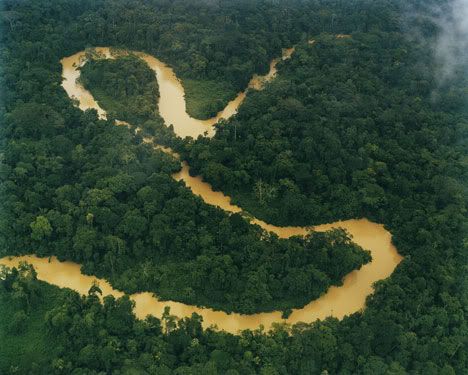
6. Due to the vast amount of water as well as sediment that are deposited where the Amazon River meets the Atlantic Ocean, the color and salinity of the Atlantic Ocean are modified for nearly 200 miles (320 km) from the delta.
7. For much of its path, the Amazon River can be as much as one to six miles wide! During flood seasons, the Amazon River can be much, much wider; some report it is more than 20 miles wide (32 km) in certain places.
8. The Amazon River taken different routes since it began to carry water. Some scientists have determined that the Amazon River even flowed west at one time or more, into the Pacific Ocean.

1. The Amazon River carries more water than any other river in the world. In fact, the Amazon River is responsible for about one-fifth (twenty percent) of the fresh water that flows into the world's oceans.
2. The Amazon River is the second longest river in the world (the Nile River in Africa is the longest) and is about 4,000 miles (6400 km) long. (In July 2007 a group of scientists reportedly determined that the Amazon River might just be the longest river in the world, taking that title from the Nile River. It will take further studies to substantiate the claim and for the Amazon River to be recognized as the longest.)

3. The Amazon River has the largest watershed (area of land that flows into the river) and more tributaries (streams that flow into it) than any other river in the world. The Amazon River has more than 200 tributaries.
4. Streams that begin in the Andes Mountains are the starting sources for the Amazon River.
5. Most of the runoff of Brazil flows into the Amazon River along with runoff from four other countries: Peru, Bolivia, Colombia, and Ecuador.

6. Due to the vast amount of water as well as sediment that are deposited where the Amazon River meets the Atlantic Ocean, the color and salinity of the Atlantic Ocean are modified for nearly 200 miles (320 km) from the delta.
7. For much of its path, the Amazon River can be as much as one to six miles wide! During flood seasons, the Amazon River can be much, much wider; some report it is more than 20 miles wide (32 km) in certain places.
8. The Amazon River taken different routes since it began to carry water. Some scientists have determined that the Amazon River even flowed west at one time or more, into the Pacific Ocean.
River Dolphin
BOTO (Amazon River Dolphin)
The Amazon River Dolphin, also called the boutu, boto, or bufeo, is the largest of the freshwater dolphins, and like all freshwater dolphins it is endangered because of hunting, human pressures, and degradation of habitat. Its most amazing characteristic is its color, which ranges -- depending on its age -- from soft, rosy pink to a vivid, almost shocking pink. The Portuguese name for this species in Brazil is "boutu vermelho" — red dolphin.
PHYSICAL DESCRIPTION: The Amazon River dolphin, or boutu, is a fresh water dolphin of medium size, with a heavy, thickset body. It has a prominent domed forehead ending in a long beak which contains 24 to 34 conical and molar-type teeth on each side of the jaws. The conical teeth are in the forward part of its mouth and are used for holding and grasping prey which is then worked to the rear of the mouth to be thoroughly crushed by the molars before being swallowed. Another unique feature of this dolphin is the presence of stiff hairs on the upper and lower portions of the beak. It is thought these hairs provide a "sense of touch" while the animal forages in the mud for food. Its mouth is wide and straight and curves upward at the corners. The neck vertebrae are not fused together and this dolphin is able to bend its neck to an angle of 90 degrees to its body, downward or sideways. Though its eyes are small its eyesight is good. The ear opening is large and the Amazon River dolphin is known to have a well developed sense of hearing.
COLOR: Its color is distinctive and varies considerably according to age. When it is young, the Amazon River dolphin is dark gray on the upper portion of its body. As it matures the gray is replaced by pink on the ventral or lower portion of the body, which spreads up the sides to the back. The color becomes lighter as the dolphin matures, and ends up almost white, with tinges of bluish-gray.

surface characteristics
FINS AND FLUKE: Instead of a dorsal fin, the boutu has a ridge on its back which rises to a modified hump at about the mid section of its body. Its flippers are large in proportion to its body and are used for steering. Its flukes are large and broad and divided by a median notch. Its unusually large flippers and flukes are probably an adaptation for maneuvering in shallow waters.
Length and Weight: Length averages about 6 feet for males (2.5 m) with a maximum of 9 feet (2.7 m); females average 6 feet (1.8 m) with a maximum of 8 feet (2.4 m). Weight is up to 350 pounds (160 kg).
Feeding: Amazon River dolphins feed on Amazon catfish and other heavily scaled fish, including piranhas, as well as bottom-dwelling crustaceans.
Mating and Breeding: The male reaches sexual maturity at about 7 feet (2 m) and the female at about 5.5 feet (1.7 m). Most calves are born between July and September after a gestation period of 9 to 12 months; they are about 32 inches long at birth (80 cm) and weigh about 15 pounds.

range map
Distribution and Migration: The boutu is found everywhere in northern and central South America from the Amazon River delta to the Andes. It is plentiful in the Amazon and its tributaries and lakes as well as the Orinoco River and its tributaries in Venezuela. It also inhabits rivers in Columbia, Ecuador, northern Peru, Brazil, and Bolivia. Depending on where it is found, differences in color, number of teeth, size, and other physical characteristics have been reported in well-separated populations. Because of these differences some scientists think boutus should be separated into different species and subspecies.
Natural History: The boutu is usually seen alone or in pairs. It is curious and is not shy about approaching boats. The sounds it makes are clearly audible and are used for echolocating prey. While echolocating, the boutu uses a scanning technique, moving its head from side to side — a maneuver made possible by the flexibility of its neck.
Status: In some parts of its range the boutu has figured prominently in the folklore of the South American Indians, who believed killing them would bring bad luck and misfortune. These taboos provided the animal with a measure of protection until new settlers began to arrive and live along the river banks. Since then large numbers of dolphins have been killed and their skins used for leather; their fat for cooking. In addition, several hundred have been captured live for display in aquariums. The U.S. alone took nearly 100 of them; less than 20 were able to adapt to captivity.
By Internet!
CLASS: Mammalia
 |
ORDER: Cetacea
SUBORDER: Odontoceti
FAMILY: Iniidae
GENUS: Inia
SPECIES: geoffrensis
The Amazon River Dolphin, also called the boutu, boto, or bufeo, is the largest of the freshwater dolphins, and like all freshwater dolphins it is endangered because of hunting, human pressures, and degradation of habitat. Its most amazing characteristic is its color, which ranges -- depending on its age -- from soft, rosy pink to a vivid, almost shocking pink. The Portuguese name for this species in Brazil is "boutu vermelho" — red dolphin.
PHYSICAL DESCRIPTION: The Amazon River dolphin, or boutu, is a fresh water dolphin of medium size, with a heavy, thickset body. It has a prominent domed forehead ending in a long beak which contains 24 to 34 conical and molar-type teeth on each side of the jaws. The conical teeth are in the forward part of its mouth and are used for holding and grasping prey which is then worked to the rear of the mouth to be thoroughly crushed by the molars before being swallowed. Another unique feature of this dolphin is the presence of stiff hairs on the upper and lower portions of the beak. It is thought these hairs provide a "sense of touch" while the animal forages in the mud for food. Its mouth is wide and straight and curves upward at the corners. The neck vertebrae are not fused together and this dolphin is able to bend its neck to an angle of 90 degrees to its body, downward or sideways. Though its eyes are small its eyesight is good. The ear opening is large and the Amazon River dolphin is known to have a well developed sense of hearing.
COLOR: Its color is distinctive and varies considerably according to age. When it is young, the Amazon River dolphin is dark gray on the upper portion of its body. As it matures the gray is replaced by pink on the ventral or lower portion of the body, which spreads up the sides to the back. The color becomes lighter as the dolphin matures, and ends up almost white, with tinges of bluish-gray.

FINS AND FLUKE: Instead of a dorsal fin, the boutu has a ridge on its back which rises to a modified hump at about the mid section of its body. Its flippers are large in proportion to its body and are used for steering. Its flukes are large and broad and divided by a median notch. Its unusually large flippers and flukes are probably an adaptation for maneuvering in shallow waters.
Length and Weight: Length averages about 6 feet for males (2.5 m) with a maximum of 9 feet (2.7 m); females average 6 feet (1.8 m) with a maximum of 8 feet (2.4 m). Weight is up to 350 pounds (160 kg).
Feeding: Amazon River dolphins feed on Amazon catfish and other heavily scaled fish, including piranhas, as well as bottom-dwelling crustaceans.
Mating and Breeding: The male reaches sexual maturity at about 7 feet (2 m) and the female at about 5.5 feet (1.7 m). Most calves are born between July and September after a gestation period of 9 to 12 months; they are about 32 inches long at birth (80 cm) and weigh about 15 pounds.

Distribution and Migration: The boutu is found everywhere in northern and central South America from the Amazon River delta to the Andes. It is plentiful in the Amazon and its tributaries and lakes as well as the Orinoco River and its tributaries in Venezuela. It also inhabits rivers in Columbia, Ecuador, northern Peru, Brazil, and Bolivia. Depending on where it is found, differences in color, number of teeth, size, and other physical characteristics have been reported in well-separated populations. Because of these differences some scientists think boutus should be separated into different species and subspecies.
Natural History: The boutu is usually seen alone or in pairs. It is curious and is not shy about approaching boats. The sounds it makes are clearly audible and are used for echolocating prey. While echolocating, the boutu uses a scanning technique, moving its head from side to side — a maneuver made possible by the flexibility of its neck.
Status: In some parts of its range the boutu has figured prominently in the folklore of the South American Indians, who believed killing them would bring bad luck and misfortune. These taboos provided the animal with a measure of protection until new settlers began to arrive and live along the river banks. Since then large numbers of dolphins have been killed and their skins used for leather; their fat for cooking. In addition, several hundred have been captured live for display in aquariums. The U.S. alone took nearly 100 of them; less than 20 were able to adapt to captivity.
Demonstrating all theme styles
Posted by Asker at 9:52 AM Labels: Blogger, Templates, Themes, TutorialsBlogger 0 comments
The purpose of this HTML is to help determine what default settings are with CSS and to make sure that all possible HTML Elements are included in this HTML so as to not miss any possible Elements when designing a site.
 Lorem Ipsum is simply dummy text of the printing and typesetting industry. Lorem Ipsum has been the industry's standard dummy text ever since the 1500s, when an unknown printer took a galley of type and scrambled it to make a type specimen book. It has survived not only five centuries, but also the leap into electronic typesetting, remaining essentially unchanged. It was popularised in the 1960s with the release of Letraset sheets containing Lorem Ipsum passages, and more recently with desktop publishing software like Aldus PageMaker including versions of Lorem Ipsum.
Lorem Ipsum is simply dummy text of the printing and typesetting industry. Lorem Ipsum has been the industry's standard dummy text ever since the 1500s, when an unknown printer took a galley of type and scrambled it to make a type specimen book. It has survived not only five centuries, but also the leap into electronic typesetting, remaining essentially unchanged. It was popularised in the 1960s with the release of Letraset sheets containing Lorem Ipsum passages, and more recently with desktop publishing software like Aldus PageMaker including versions of Lorem Ipsum.
» A paragraph format
A blog a contraction of the term weblog is a type of website, usually maintained by an individual with regular entries of commentary, descriptions of events, or other material such as graphics or video. Entries are commonly displayed in reverse-chronological order.
» A paragraph as blockquote
Web design is the skill of creating presentations of content (usually hypertext or hypermedia) that is delivered to an end-user through the World Wide Web, by way of a Web browser or other Web-enabled software like Internet television clients, microblogging clients and RSS readers.
Testing the Typographical Elements
The purpose of this HTML is to help determine what default settings are with CSS and to make sure that all possible HTML Elements are included in this HTML so as to not miss any possible Elements when designing a site .
.
Lorem Ipsum is simply dummy text of the printing and typesetting industry. Lorem Ipsum has been the industry's standard dummy text ever since the 1500s, when an unknown printer took a galley of type and scrambled it to make a type specimen book. It has survived not only five centuries, but also the leap into electronic typesetting, remaining essentially unchanged. It was popularised in the 1960s with the release of Letraset sheets containing Lorem Ipsum passages, and more recently with desktop publishing software like Aldus PageMaker including versions of Lorem Ipsum.
 .
.Lorem Ipsum is simply dummy text of the printing and typesetting industry. Lorem Ipsum has been the industry's standard dummy text ever since the 1500s, when an unknown printer took a galley of type and scrambled it to make a type specimen book. It has survived not only five centuries, but also the leap into electronic typesetting, remaining essentially unchanged. It was popularised in the 1960s with the release of Letraset sheets containing Lorem Ipsum passages, and more recently with desktop publishing software like Aldus PageMaker including versions of Lorem Ipsum.
Đăng ký:
Bài đăng (Atom)

